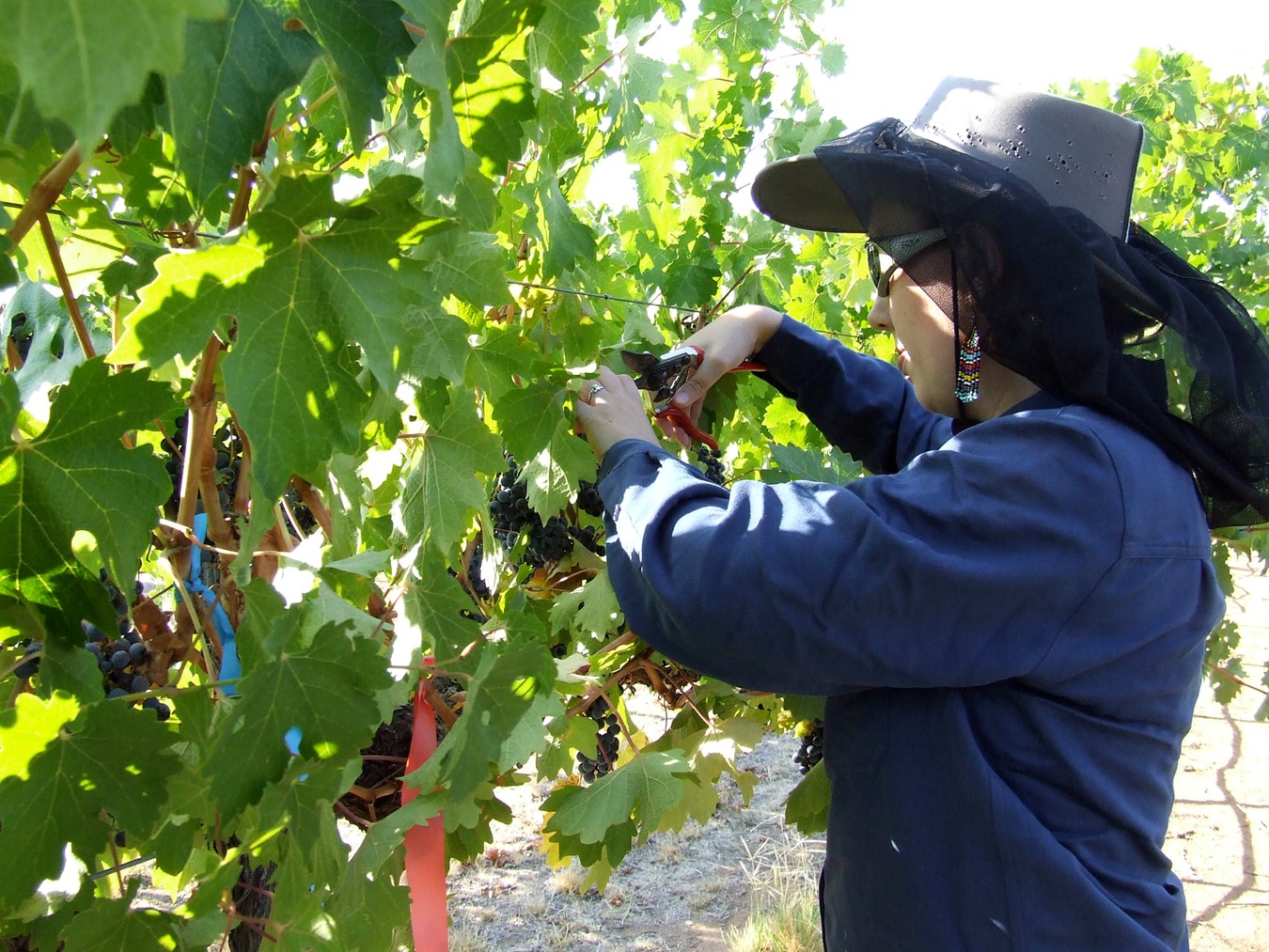- GVP $2,397 million est. Down 5% year-on-year.
- Exports of horticultural products totalled $297.4 million in 2021-22.
- 80,316 hectares were used by horticultural industries in 2020-21.
Horticulture output by value, 2020-21 73
-
Nurseries, Cut Flowers & Turf
- Nurseries
- Cultivated turf
- Cut flowers
-
Vegetables
- Tomatoes
- Mushrooms
- Cucumbers
- Other vegetables
-
Fruit
- Oranges
- Blueberries, Rubus berries
- Apples
- Other Fruit (Excl. wine grapes)
-
Nuts
- Macadamias
- Almonds
- Other nuts
The COVID-19 pandemic has continued to impact horticultural production including supply chain disruptions to exports and labour availability for the labour-intensive fruit and vegetable production systems. Labour use on NSW horticultural farms was estimated to be 7.3% lower in 2020-21 than in the prior year, reflecting in part constrained labour supply. 70 Farmers adapted to this limited supply through changing crop mixes in the case of annual crops to those with lower labour requirements, changed management practices and, where possible, substituted labour with mechanised processes.
Horticultural production was impacted by wet conditions and flooding through many growing regions in NSW both in 2020-21 and 2021-22. With excessive rain for many areas in eastern Australia, production and quality of vegetables and fruit suffered in a number of key growing areas. This led to supply constraints for some horticultural products in domestic markets and in particular for vegetables, with key regions impacted by flooding. Vegetable prices at the retail level, as measured by the consumer price index, increased 16% over the twelve months to June 2022. 197
2022 has also seen the identification of a Varroa mite incursion impacting honeybees in a limited number of hives. In the immediate term, biosecurity measures applied to eradicate the pest has the potential to limit the availability of optimal pollination services provided by beekeepers to key horticultural industries such as almonds, macadamias, berries and some orchard crops.
Fruit and vegetable price trends 197
- Sydney Fruit CPI
- Sydney Vegetable CPI
- National Fruit CPI
- National Vegetable CPI
Nuts
NSW nut production (tonnes, in shell equivalent) 75
- Almond
- Chestnut
- Hazelnut
- Macadamia
- Pecan
- Pistachio
- Walnut
NSW nut exports totalled $92 million in 2021-22 with major markets including China, Japan and South Korea and European countries such as Belgium and Netherlands. 35
While tonnages of macadamias produced in the state has not increased substantially over the same period, the greenfield planting in the Clarence Valley has yet to reach maturity and be fully reflected in production. 78
Australian almond production represented 8% of global production in 2021-22, the second largest producer behind the United States which accounted for 78% of production. 80 The almond demand-supply imbalance has seen global prices, based upon US prices, at decadal lows in 2020 and 2021 averaging US$1.71 per pound and US$1.76 per pound respectively compared to the 10-year average to 2019 of US$2.66 per pound. 82 Increasing demand as global markets adjust post the COVID-19 pandemic and lower production from California for the 2022 crop over the previous year, are expected to moderate the demand-supply imbalance which should support prices. US almond production from California is anticipated to be 11% lower than last year, with the crop impacted by frosts early in the growing season and continuing drought conditions. 83
NSW almond exports to India and China represented 60% and 33% of total export value in 2021-22. 35 India with its increasing wealth and interest in healthy foods is experiencing growing demand for nut sourced product. Under the recently agreed Australia and India Free Trade Agreement there is a 50% reduction in tariffs for 34,000 tonnes of almonds (for in-shell and kernel) annually, improving Australian product’s competitiveness against Californian product. 84 In 2021-22 Australia exported 20,192 tonnes of almonds to India which included both shelled and in-shell. 35
Another uncertainty impacting the 2022-23 almond and macadamia outlooks is the Varroa Mite outbreak reported in NSW in June 2022. 71 Subsequent biosecurity control measures have resulted in restricted movements of hives into horticultural regions for pollination services for the start of flowering in late winter and spring. Almond trees, and to a lesser degree macadamia which also benefit from native insect pollinators, 89 are dependent upon European honeybees for effective pollination. For example NSW almonds require an estimated 81,000 hives for the area planted in 2022. Suboptimal pollination of tree nut crops could impact yields for the 2022-23 production.
Fruit
Production of blueberries and Rubus berries continued to increase, up 11% and 12% respectively in 2020-21, with blueberries totalling 20,075 tonnes and Rubus berries 2,533 tonnes in 2020-21. 91 75 However, the value of berry production (excluding strawberries) fell slightly, down 1% to $254.3 million in 2020-21. 74 The decline in value reflects, in part, the increasing supply from NSW growers leading to short term downward price pressures during peak summer supply in the Australian market. 107 NSW production of blueberries has increased 240% over the 5 years to 2020-21. 75
The value of fruit exports totalled $94.0 million in 2021-22, compared with $95.1 million in the previous year, a decrease of 1%. 35 The major destinations for fruit exports included Hong Kong and China with exports valued at $21.3 million (down 30%) and $13.3 million (up 14%) respectively in 2021-22. The value of fruit exports to Singapore eclipsed those to China in 2021-22 and was 40% higher than the prior year with exports of avocados to this market increasing threefold in 2021-22 over the prior year to total $3.2 million. In volume terms Singapore received 717 tonnes of avocados in 2021-22, up from 126 tonne in the prior year. 35
NSW Fruit export destinations 2021-22 35
- Hong Kong
- Singapore
- China
- Japan
- United Arab Emirates
- United States
- Canada
- Malaysia
- Other
Avocado exports, although from a low base, increased in value terms by 150% year-on-year to total $9.95 million. The volume of crop exported rose significantly up from 581 tonnes in the prior year to total 2,195 tonnes in 2021-22. 35 Export markets will be an important factor in countering the increased national supply for avocados which has resulted in significant domestic retail price declines during the seasonal supply peaks, as more trees come into bearing age.
The average national retail price in June averaged $2.11 per single fruit over the three years to June 2020, with the price decreasing over the last two years to average $1.50 per fruit in June 2022. 92 93 National avocado production is expected to increase by 30% for the 12 months to September 2022, over the prior 12-month corresponding period. 94 In the case of NSW avocado production, production from the main growing regions of Central NSW is expected to decline and be 23% lower over the 12 months period to September 2022. 94
Vegetables
Demand for fresh vegetables was sustained as markets adapted after the significant COVID-19 pandemic impacts with prices for most vegetables increasing. The increased value of vegetable production came despite continued industry challenges with tight labour supply continuing to impact intensive vegetable production systems. 95 Locally, impacts from floods in the first half of 2021 resulted in lost production in the Greater Sydney regions and the North Coast, with the Hawkesbury Valley an important area for brassicas, lettuce, Asian vegetables, sweet corn and pumpkin production. 97
Vegetable exports by value increased in 2021-22 by 15% to total $38.5 million. The major export crop by value was potatoes which increased 33%. Singapore and South Korea remain the dominant markets representing exports totalling $7.2 million and $7.0 million respectively. The third most valuable export market in 2021-22 was New Zealand, which increased 78% year-on-year to be valued at $3.5 million. Vegetable exports to Thailand also increased substantially from $0.6 million in 2020-21 to $3.0 million in 2021-22, boosted by exports of potato valued at $1.8 million totalling 3,022 tonnes. 35
Nurseries & Turf
Turf production by species in NSW, 2020-21 (Million m2) 100
- Buffalo
- Couch/Hybrid couch
- Kikuyu
- Zoysia
- Other specialty grass
The shift in demand for nursery plants arising from the COVID-19 pandemic appears to have been sustained with strong demand from households and community segments. 99 However, within an increasing interest rate cycle, the discretionary nature of some of these purchases may impact demand in the outlook period.
Turf production was valued at $146.8 million which was a 27% increase over the 2019-20 value of production. 73 74 Contributing to the increase in the value of production were higher turf prices in 2020-21 which ranged from a 9% increase for Buffalo, to 27% for Zoysia and 29% for Couch/Couch Hybrids in 2020-21. 100 102 The majority of turf sales from growers is direct to end users (37%) or to landscapers and turf installers (36%), while wholesalers and retailers are smaller sales channels. 100
Repeated flooding events during 2021 and again in 2022 have had a substantial impact on turf growers which are concentrated close to end markets in the greater Sydney Region and the Hunter. The ultimate impact of such flooding depends upon numerous factors such as, the stage of growth with mature swards close to harvest especially vulnerable, and the species grown. Kikuyu is a major turf species grown in NSW, representing an estimated 35% in volume terms in 2020-21, 100 and is more susceptible to flood damage than stiffer grasses. 103 These flooding events over the two years and their severity is expected to have impacted turf grower production and infrastructure over the outlook period.
Cut Flowers
Cut flower exports remain small and focussed on native flowers totalling $143,000 in 2021-22. 35 Further, displacement of locally produced flowers with imported flowers continues with imports increasing in value terms by 17% to $37.8 million in 2021-22 over the previous year highlighting the labour cost advantages in these countries. 35 104
NSW cut flower imports by value (A$ million) 35
- China
- Kenya
- Colombia
- Ecuador
- Malaysia
- Taiwan
- Other
While there has been rising interest from domestic consumers regarding the origin of cut flowers, price competition is still a primary driver. 104 As a discretionary item, any changes in consumer spending as a result of higher inflation and interest rates observed in 2022 105 will likely reduced demand for cut flowers and result in increased substitution of locally produced product with lower priced imported flowers typically retailed through supermarkets. 104
Value of NSW cut flower imports by type, 2021-22 ($, million) 35
- Roses
- Carnations
- Orchids
- Chrysanthemums
- Other fresh flowers
- Dried flowers
- Foliage
Stronger Primary Industries Strategy
AgSkilled 2.0
AgSkilled™ 2.0 is a $15 million investment by the NSW Government to upskill and better prepare the agricultural workforce for fast-moving change driven by industry innovation, research and technology through vocational education and training (VET), particularly in the plant-based fibre (e.g. cotton), grains, production horticulture, viticulture and rice growing agricultural industry sectors across rural and regional NSW.
Strategic Outcome


Tocal College is a RTO, and was established in 1965 to fill a gap in agriculture and land management training and continues to maintain a strong industry reputation. Beyond vocational education and training, Tocal also partners with DPI R&D teams to deliver industry adoption programs.
Tocal courses include Drones in Agriculture, Advanced Spray Application, Introduction to Agronomy, Harvest Operations, Corporate Governance and Generating Regional Outstanding Women (GROW).
For producers and employers, AgSkilled 2.0 allows you to build the productivity of your business by upskilling existing workers and providing new industry entrants with training in the skills you need, now and into the future.
For more information, visit www.tocal.nsw.edu.au/courses/short-courses/agskilled


